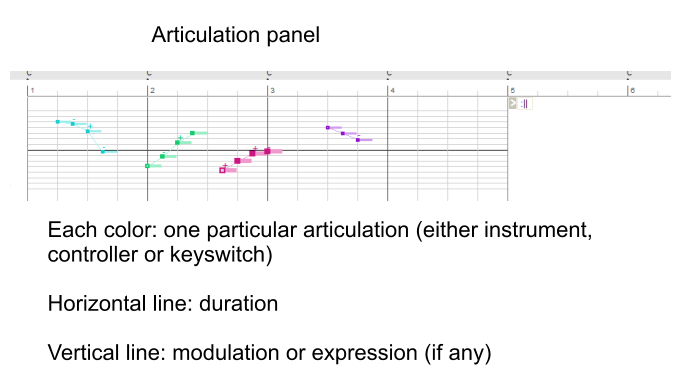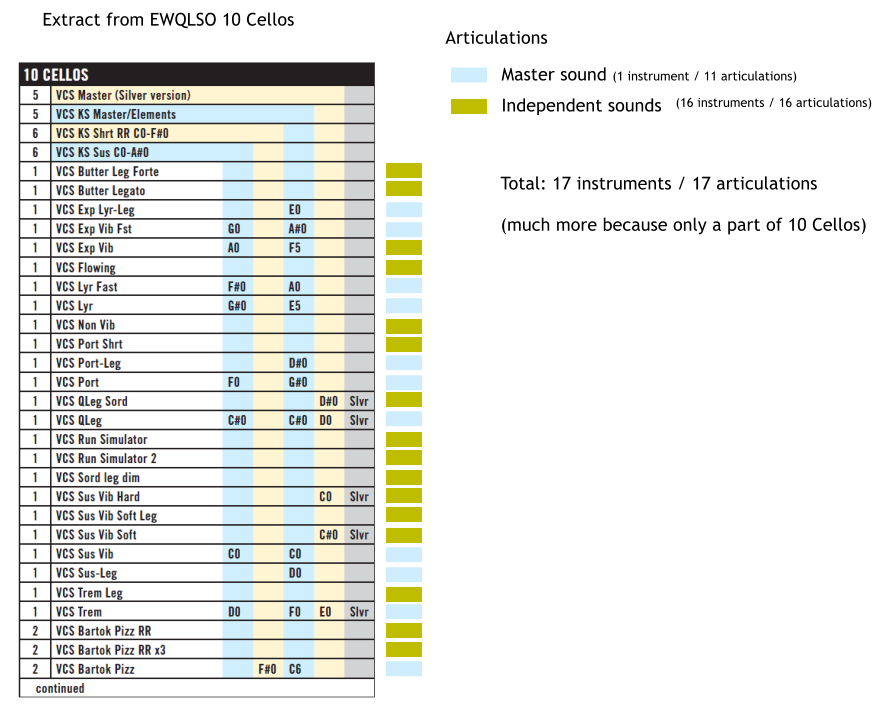
Posted
I came upon an interesting topic about the articulation form and names:
(https://users.cognitone.com/node/1446&highlight=articulation)(https://users.cognitone.com/node/1446&highlight=articulation)
but i would like to speak about the content.
It seems to me that depending of one's soundbank and VST effects, there are three possibilities:
- loading one sound (or one instrument) for each articulation (one midi channel by articulation, so several midi channels for one global instrument),
- loading a master sound on one midi channel with integrated keyswitches (don't know really if those are the one called "multi-timbral"),
- finally, using Midi controllers with associated effects for mimicing articulations.
So, the way one builds one's devices according to those choices will condition how one works with articulations in a later time.
Please correct me if i miss or confuse something.
What is the most efficient approach for dealing with articulations ?
Would it be possible to create an articulation menu (as figures, take, velocity and so on) where one could deal with all articulations at the same time ? Or would that complexify the thing furthermore ?
The articulation approach by segment seems to work well in the case of a master sound, but it is not anymore relevant if one loads several instruments corresponding to each articulation.
Sat, 2010-05-22 - 11:58 Permalink
I mean: one can imagine an articulation track, allowing to set up segments of articulation, each articulation being affected to a color (each instrument having its own color).
Therefore, one colored articulation segment would affect only the associated instrument, but all articulations would be commanded by one single articulation panel or track, that one could also previsualize under each track as the actual arrangements tracks allows that feature.
Which is: articulations would be linked to phrases through an articulation panel.
Edit: an image for visualizing the idea.
(articulation panel.PNG)

Sat, 2010-05-22 - 16:47 Permalink
When one considers libraries like EWQLSO, the number of articulations can grow very quickly.
Here is an excerpt from the list of articulations of 10 Cellos from EWQLSO. The master with keyswitches doesn't have all articulations. So many are only available as separate instruments.
I don't have it, but if some users want to associate synfire with by example EWQL Hollywood Strings, the number of articulations is even far much important.
I don't even consider the possibility of composing multiple articulations together.
edit: typography error on the schema below: 27 and no 17 articulations.
(10cellos.PNG)

Sun, 2010-05-23 - 11:03 Permalink
So...
[quote]Dynamics:
Forte (f, mf, ff, fff)
Piano (p, mp, pp, ppp)
Sforzando
Staccato
those are already linked to the velocity parameter, so it should not be too much complicated to link those articulations with the velocity vectors.
Sun, 2010-05-23 - 16:03 Permalink
Much better, one could imagine an articulation parameter into one unique color for each phrase, and with subparameters associated to each segment for describing the specific articulation in use (cf the figure below)
This could benefit of a standardization of the names of articulation as described in Andre's post (cf first message)
I say that, but i'm no programmer, so i let the professional team pondering on this.
(articulation.PNG)

Sun, 2010-05-23 - 18:27 Permalink
The violin, in the soundbank, is composed of a master sound with keyswitches, and independent sounds for particular articulations, cross-fade effects and other scripts.
The keyswitches and some articulations effects are set up for the master sound via the articulation panel of Synfire. However, if one wants to play with the highest range of possible articulations, one needs as many supplementary phrases with independent sounds as one needs articulations, in addition to the phrase of the master sound for the violin partition.
This configuration may lead to a simple violin partition splitted up in ten phrases or more in some cases, which may not be very convenient.
Now, if one has an articulation layer or panel. One begins with a violin phrase set up with a default articulation. It may be a master sound, or a default sound.
In completion to the violin figure, one draws into the articulation layer articulations figures which would be applied to the default violin figure if the articulation layer is activated.
Which means that one could make any kind of change to the articulations, but the default instrument figure will stay safe.
Now, in the articulation layer, one could draw segments for each particular articulation available in the device description (either keyswitches, new instruments or controllers), and this will visually reflect in some way or another by different colors, or by abbreviations like in the schema above.
Therefore, the violin partition would be contained into one unique phrase, independently of how many sounds could be used for its articulations.
Mon, 2010-05-24 - 15:50 Permalink
Thanks for your detailed suggestions. We appreciate that. We have a lot of items on our todo lists that roughly group into these categories:
A) Make as many parameters as possible become portable across sound libraries: Symbolic names + response curves + normalized values (-1.0 ... 1.0)
B) Make articulations and custom CCs portable as well.
C) Provide features that allow for comfortable high-level control of abstract ideas like "drama", "tension", "density", etc.
All this boils down to detailed research on currently available sound libraries and a proper modelling/abstraction. This is a lot of work, but definitely possible.
Concerning multi-sound articulations, I can imagine a fully transparent way of supporting these in a single Figure only. The articulation could generate output for a different sound automatically without requiring the user to know anything about it.
Mon, 2010-05-24 - 16:13 Permalink
Thanks Andre, that looks quite interesting, i'm glad to have found Cognitone software.
By the way, i would have another tiny suggestion, about the device descriptions panel:
would it be possible to add '+' and '-' buttons for new sounds, like in the articulation panel ?
this would save a lot of time for setting up large devices.
Some libraries are quite huge, i think to titan, or even the Vienna Symphonic Orchestra (though i don't have those).
Mon, 2010-05-24 - 18:56 Permalink
Well i didn't take care, but into the actual articulation panel there is an option for program change, so i suppose one can change sounds inside a phrase for articulations.
This feature doesn't figure in the printed manual, it's why i was asking this question into this post.
Now, it seems that it is already solved.
Tue, 2010-05-25 - 18:59 Permalink
The program change might work with some libraries or hardware. Although it's probably not the best solution yet. Depends on how the library interprets the program change message. If it just routes all notes to an alternative sound internally (i.e. works like a key switch), that would be fine. If it swaps patches including sample data, that might not work fast enough.

